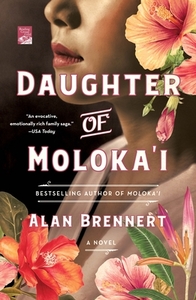You need to sign in or sign up before continuing.
Take a photo of a barcode or cover
emotional
inspiring
reflective
sad
medium-paced
Plot or Character Driven:
Character
Strong character development:
Yes
Loveable characters:
Yes
Diverse cast of characters:
Yes
Flaws of characters a main focus:
No
Normally, I’d be too irritated at waiting sixteen years for a sequel to be happy about it. However, I never expected a sequel to Moloka’i, an absolutely fantastic historical novel about the leper colony on the island of Moloka’i, so this book’s existence just felt like a big fat Christmas present. It follows the story of Rachel’s daughter, Ruth, as she is adopted by a Japanese family and eventually ends up interred at Manzanar during WWII with her family. Rachel and Ruth reconnect in the last section of the book, and the novel is a beautiful tale of survival, love, and family.
This is only the second book I’ve ever read that has setting in the Japanese internment camps. We need more exposure to this topic!
emotional
hopeful
inspiring
sad
fast-paced
Plot or Character Driven:
Character
Strong character development:
Yes
Loveable characters:
Yes
Diverse cast of characters:
Complicated
Flaws of characters a main focus:
Yes
Very few books make me cry. Moloka'i and Daughter of Moloka'i have some overlap and I knew what was going to happen the recitation of ancestors made me cry. It was great getting the stories of both women - a mother and a daughter torn apart from Hanson's Disease and adoption. I really didn't think Daughter of Moloka'i could live up to Moloka'i because it is a squeal to a great book - I was wrong. Ruth's story is as great as Rachel's story was - it runs you through the emotions of happiness, sadness, and anger. Also timeless as we need to be more aware of the treatment of the Japanese - before, during, and after World War II. I will say there are parts of the book that maybe a bit drawn out especially involving pets, but yet they do play an important role in Ruth's life.
Such a beautiful book. This author has really touched my soul. This is the story of how Ruth and her family end up in internment camps with other Japanese who are living in the US. It also follows the reunion of Rachel with the daughter she was forced t give up at birth. So heartwarming and heartbreaking.
emotional
informative
reflective
sad
slow-paced
Plot or Character Driven:
A mix
Strong character development:
Yes
Loveable characters:
Complicated
Diverse cast of characters:
No
Flaws of characters a main focus:
Yes
4.5 stars rounded up to 5
Having read Alan Brennert’s masterpiece Moloka’i (published back in 2004) for the first time just last month – a book whose story and characters I fell head over heels in love with – I went into the sequel Daughter of Moloka’i with extremely high anticipation. I knew that this second book would be about Ruth – the daughter that Rachel had been forced to give up in the original story – and also that it would expand upon the reunion scene as well as Ruth and Rachel’s subsequent 22 year relationship that were all only briefly mentioned in the first book. What I wasn’t expecting was that this part of the story (the connection back to Moloka’i and Rachel’s story) would only be covered in less than a third of the book. Perhaps it was because the story in Moloka’i had done such a number on my heart and Rachel as well as the other characters in there were so memorable and beloved to me, to the point that I was expecting that connection to play a more central role in the sequel. Don’t get me wrong though….I’m not saying that I’m disappointed because I’m truly not, as the story in Daughter of Moloka’i was still beautifully rendered and the historical significance of everything that had happened during World War II – specifically, in this case, the Japanese internment camps across the U.S. and the suffering across the board during the war – was well-depicted in a story that was necessary to be told. I also grew to love Ruth and all the other characters in this story and just like with Moloka’i, I found this to be a hugely emotional read – one that made me cry but also made me smile at certain parts, a story that covered similar themes of family, love, and strength in the face of adversity. Brennert also did a fantastic job incorporating the various aspects of Japanese culture into the story, which I definitely appreciated given that I wasn’t too familiar with the culture and so was able to greatly expand my knowledge after reading this book.
With all that said, the best way to describe my feelings toward this book is this: taken on its own merit, this was an excellent read, and if it had been a standalone novel with no connection to a previous story, I would absolutely rate it 5 stars without question….but as a sequel to the exquisite, beloved, “one-of-a-kind” Moloka’i (now officially on my “favorites of all-time” list), I have to admit that this one fell a tad bit short for me in terms of how long it took to re-connect with Rachel’s story. Once that reconnection was made though, it was absolutely perfect! The way Brennert wrapped up Rachel’s story and intertwined it with Ruth’s in the end was wonderful and quite frankly, it turned my heart to mush all over again. In the end, I decided to give this one 4.5 stars rounded up to 5 because for me, Moloka’i had what I can only describe as a “magical” quality to it that made it such a special read (one that I can’t stop thinking about even now) and while Daughter of Moloka’i was wonderful in its own right, it didn’t quite replicate that “magic” for me, at least not until the last third of the book. Regardless though, this sequel is still a “must-read,” especially for those who read the first book.
And here is where my opinion differs from most of the other reviewers: this is one of those sequels where I feel that knowing the backstory makes a world of difference. While yes, it’s true that this can technically be read as a “standalone” for those who choose to do so, I strongly recommend reading Moloka’i first before attempting this one, as there is too much important background information about Rachel and what she went through in the first story that impacts Ruth’s story, to the point that, I feel, it’s impossible to experience the full effect of this story without that one. For me, I’m tremendously glad that I got the chance to read both books in order…not only that, I now also have yet another “favorite author” to add to my ever-growing list. I look forward to reading whatever historical novel Brennert chooses to write next – I just hope we don’t have to wait another 15 years for it!
Received ARC from St. Martin’s Press via NetGalley
Having read Alan Brennert’s masterpiece Moloka’i (published back in 2004) for the first time just last month – a book whose story and characters I fell head over heels in love with – I went into the sequel Daughter of Moloka’i with extremely high anticipation. I knew that this second book would be about Ruth – the daughter that Rachel had been forced to give up in the original story – and also that it would expand upon the reunion scene as well as Ruth and Rachel’s subsequent 22 year relationship that were all only briefly mentioned in the first book. What I wasn’t expecting was that this part of the story (the connection back to Moloka’i and Rachel’s story) would only be covered in less than a third of the book. Perhaps it was because the story in Moloka’i had done such a number on my heart and Rachel as well as the other characters in there were so memorable and beloved to me, to the point that I was expecting that connection to play a more central role in the sequel. Don’t get me wrong though….I’m not saying that I’m disappointed because I’m truly not, as the story in Daughter of Moloka’i was still beautifully rendered and the historical significance of everything that had happened during World War II – specifically, in this case, the Japanese internment camps across the U.S. and the suffering across the board during the war – was well-depicted in a story that was necessary to be told. I also grew to love Ruth and all the other characters in this story and just like with Moloka’i, I found this to be a hugely emotional read – one that made me cry but also made me smile at certain parts, a story that covered similar themes of family, love, and strength in the face of adversity. Brennert also did a fantastic job incorporating the various aspects of Japanese culture into the story, which I definitely appreciated given that I wasn’t too familiar with the culture and so was able to greatly expand my knowledge after reading this book.
With all that said, the best way to describe my feelings toward this book is this: taken on its own merit, this was an excellent read, and if it had been a standalone novel with no connection to a previous story, I would absolutely rate it 5 stars without question….but as a sequel to the exquisite, beloved, “one-of-a-kind” Moloka’i (now officially on my “favorites of all-time” list), I have to admit that this one fell a tad bit short for me in terms of how long it took to re-connect with Rachel’s story. Once that reconnection was made though, it was absolutely perfect! The way Brennert wrapped up Rachel’s story and intertwined it with Ruth’s in the end was wonderful and quite frankly, it turned my heart to mush all over again. In the end, I decided to give this one 4.5 stars rounded up to 5 because for me, Moloka’i had what I can only describe as a “magical” quality to it that made it such a special read (one that I can’t stop thinking about even now) and while Daughter of Moloka’i was wonderful in its own right, it didn’t quite replicate that “magic” for me, at least not until the last third of the book. Regardless though, this sequel is still a “must-read,” especially for those who read the first book.
And here is where my opinion differs from most of the other reviewers: this is one of those sequels where I feel that knowing the backstory makes a world of difference. While yes, it’s true that this can technically be read as a “standalone” for those who choose to do so, I strongly recommend reading Moloka’i first before attempting this one, as there is too much important background information about Rachel and what she went through in the first story that impacts Ruth’s story, to the point that, I feel, it’s impossible to experience the full effect of this story without that one. For me, I’m tremendously glad that I got the chance to read both books in order…not only that, I now also have yet another “favorite author” to add to my ever-growing list. I look forward to reading whatever historical novel Brennert chooses to write next – I just hope we don’t have to wait another 15 years for it!
Received ARC from St. Martin’s Press via NetGalley
emotional
informative
reflective
sad
slow-paced
Plot or Character Driven:
Plot
Strong character development:
Yes
Loveable characters:
Yes
Diverse cast of characters:
Yes
Flaws of characters a main focus:
No





